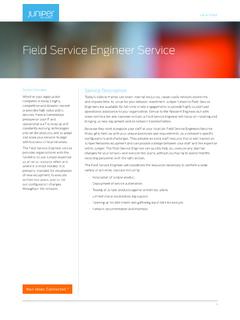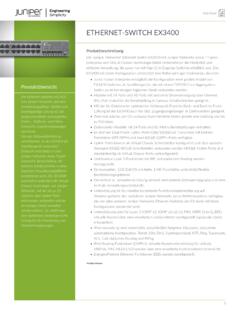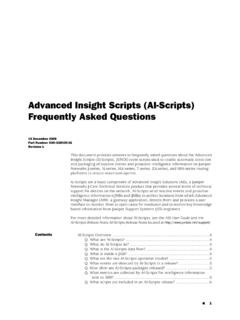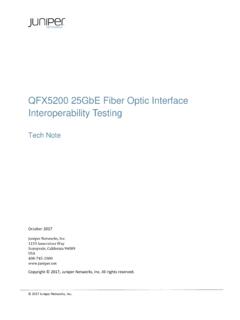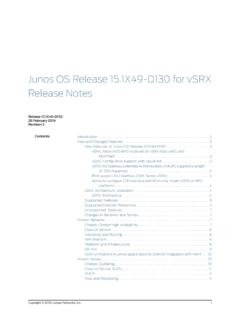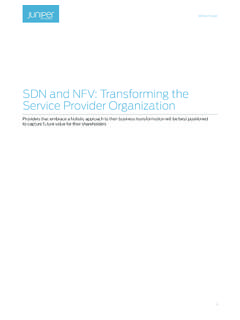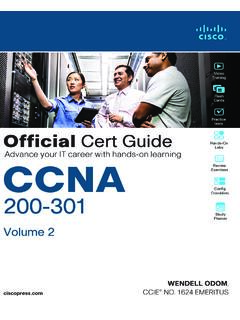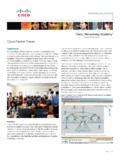Transcription of Day One: Data Center Fundamentals - Juniper
1 Fundamentals SeriesLearn all the basics of data centers, from components to cabling to controllers, and how Juniper products scale that technology. It s day one, and you have a data Center to Colin Wrightson DAY ONE: DAtA Center FUNDAMENtALSJ uniper Networks Books are singularly focused on network productivity and efficiency. Peruse the complete library at DAY ONE: DAtA Center FUNDAMENtALSDay One: Data Center Fundamentals provides a thorough understanding of all the com-ponents that make up a data Center solution using Juniper Networks products and networking technologies. You ll learn how key data Center principles fit together by using an example architecture that is common throughout the book, providing an easy reference point to gauge different data Center book s end, you ll be able to design your own data Center network and in the pro-cess come to understand why you would favor one technology or design principle over another.
2 The author points out subtle differences along the way, and provides links to authoritative content that will help you with the technical specifications of the compo-nents, protocols, controllers, and configurations. ISBN 978-1-941441-39-8978194144139851800 Data Center architectures are evolving at an exponential rate. With the cloud reaching maturity and SDN s rise from the trough of disillusionment towards the plateau of profitability an update on the new Fundamentals of data Center architecture is long over-due. Colin Wrightson tackles the topic head-on in this excellent new addition to the Day One library. Perry Young, SVP, Tier-1 US Bank, Juniper Ambassador, JNCIP-SEC/SP/ENT, JNCDS-DC This very timely book is essential reading if you want to keep up with the rapidly chang-ing world of data centers. It takes you all the way from cabling to SDN technology, ex-plaining all the fundamental principles in a well-written, easily digestible format.
3 Julian Lucek, Author and Distinguished Engineer, Juniper Networks After years of remaining relatively static, the designs and technologies behind a data Center network are now evolving rapidly. The speed of change makes it difficult to keep up with the latest architectures and technologies. Colin Wrightson, one of the data cen-ter wizards at Juniper Networks, has done of an amazing job of explaining these design choices and technologies in a simple, easy-to-read book. Highly recommended for any-one who is considering implementing a new data Center network. Andy Ingram, VP Data Centers, Center of Excellence, Juniper Colin WrightsonDay One: Data Center FundamentalsChapter 1: Common Components ..9 Chapter 2 : Architectures ..19 Chapter 3: Cabling ..27 Chapter 4: Oversubscription ..33 Chapter 5: Fabric Architecture ..45 Chapter 6: IP Fabrics and BGP.
4 65 Chapter 7: Overlay networking ..79 Chapter 8: Controllers ..93 Chapter 9: EVPN Protocol ..107 Summary ..121 2016 by Juniper Networks, Inc. All rights reserved. Juniper Networks and Junos are registered trademarks of Juniper Networks, Inc. in the United States and other countries. The Juniper Networks Logo, the Junos logo, and JunosE are trademarks of Juniper Networks, Inc. All other trademarks, service marks, registered trademarks, or registered service marks are the property of their respective owners. Juniper Networks assumes no responsibility for any inaccuracies in this document. Juniper Networks reserves the right to change, modify, transfer, or otherwise revise this publication without notice. Published by Juniper Networks BooksAuthor & Illustrations: Colin WrightsonTechnical Reviewers: Anoop Kumar Sahu, Oliver Jahreis, Guy Davies, Thorbjoern Zieger, Bhupen MistryEditor in Chief: Patrick AmesCopyeditor and Proofer: Nancy KoerbelISBN: 978-1-941441-39-8 (paperback)Printed in the USA by Vervante : 978-1-941441-40-4 (ebook)Version History: v1, September 2016 About the Author Colin Wrightson is a Consultant System Engineer with the EMEA Center of Excellence team focusing on data Center product and design and has been with Juniper Networks for over six years.
5 His previous roles within Juniper have been Systems Engineer and Senior Systems engineer for enterprise covering government and defense sectors. Prior to Juniper he worked for cisco partners as field engineering, engineering lead, and then pre-sales, before seeing the error of his ways and joining Juniper . Author s AcknowledgmentsI d like to thank Patrick Ames who has spent far too long correcting my questionable grammar and spelling with the help of Nancy Koerbel. Thank you to the technical reviewers. I d also like to thank Bhupen (social media assassin) for his continued encouragement during this process, Mark Petrou (big cod), who first gave me theidea for a book, and Starbucks, whose coffee made a lot of early morning writing easier. Last, but most impor-tantly not least, I want to thank my long-suffering and loving wife who makes all of this possible.
6 Oh, and hello to Jason iv Welcome to Day One This book is part of a growing library of Day One books, produced and published by Juniper Networks Books. Day One books were conceived to help you get just the information that you need on day one. The series covers Junos OS and Juniper Networks networking essentials with straightforward explanations, step-by-step instructions, and practical examples that are easy to follow. The Day One library also includes a slightly larger and longer suite of This Week books, whose concepts and test bed examples are more similar to a weeklong seminar. You can obtain either series, in multiple formats: Download a free PDF edition at Get the ebook edition for iPhones and iPads from the iTunes Store. Search for Juniper Networks Books. Get the ebook edition for any device that runs the Kindle app (Android, Kindle, iPad, PC, or Mac) by opening your device s Kindle app and going to the Kindle Store.
7 Search for Juniper Networks Books. Purchase the paper edition at either Vervante Corporation ( ) or Amazon ( ) for between $12-$28, depending on page length. Note that Nook, iPad, and various Android apps can also view PDF files. If your device or ebook app uses .epub files, but isn t an Apple product, open iTunes and download the .epub file from the iTunes Store. You can now drag and drop the file out of iTunes onto your desktop and sync with your .epub device. v vi Audience and Scope of This BookThis book is intended for both Enterprise and service provider engineers, network administrators, network designers/architects, and anyone who wants to understand the basic principles of data Center design. This book provides field-tested solutions for common data Center network deployment scenarios, as well as the brief background information needed to understand and design these solutions for your own chapters of this book are organized in a logical sequence to help provide the reader with a step-by-step understanding of data Center design principles and how these principles can then be developed into a solution that fits the role of a modern data You Need to Know Before Reading This Book Before reading this book, you should have a basic understanding of network protocols and general design terms.
8 While this book does not cover Junos operating systems and configurations, there are several excellent books on learning Junos in the Day One library at at This book makes a few assumptions about you, the reader: You have a basic understanding of Internet Protocol (IP) versions 4 and 6 You have a basic understanding of network design at a campus level You work with servers and want to understand the network side of data centersWhat You Will Learn by Reading This Book Basic principles of data Center design and how they have evolved How different data Center designs affect applications What overlay and underlay are, and why they are important How Controller and Controllerless networks can improve Layer 2 scale and operations A better understanding of Juniper data Center products viiPrefaceThis Day One book provides you with a thorough understanding of all the components that make up a Juniper Networks data Center solution.
9 In essence, it offers a 10,000 foot view of how everything regarding Juniper s data Center solution fits together. Such a view enables you to see the value Juniper provides over other vendors in the same space by glimpsing the big picture. This books starts by covering the basics and slowly builds upon core ideas in order to cover more complex elements. Design examples relate back to an example architecture that is common throughout the book, thus providing an easy reference point to gauge guideline solutions. The idea is to allow you to design your own network and, in the process, come to understand why you would favor one technology or design principle over another. In order to do that, this book points out subtle differences along the way: Chapter One: Common Components starts with the various common components (products) you can use and where they sit in the design topology.
10 This is important because of the differences between merchant silicon and custom silicon, and because different vendors have different approaches and those approaches can affect the network and services you may want to implement. Chapter Two: The Top-of-Rack or End/Middle-of-Row chapter looks at the different architectures you can use, depending on your server selection, contention ratio, and overall rack and cabling design. Chapter Three: Cabling is sometimes a neglected element of the larger design, but it can have interesting repercussions if not considered. Chapter Four: Over Subscription is the first design point to think about when designing a network. If you know the speeds at which your servers are connecting, and the bandwidth they are going to need, not just on day one but also ex-number of years from now, then you can start the design process and select the right products and speeds for your network.

